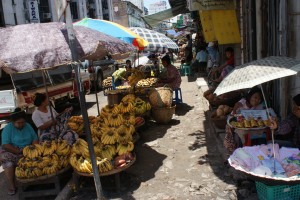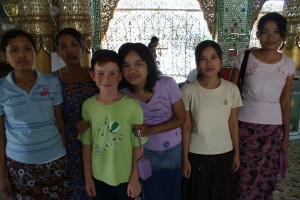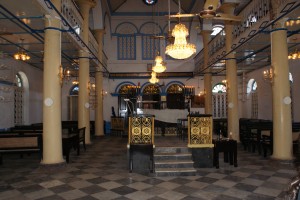TO NEW READERS OF THIS BLOG:
Welcome to the Myanmar / Burma section of the Blog. If you are considering a trip to Myanmar, I think you’ll learn a lot from my family’s own experience – we traveled to Myanmar in July/August 2011 for 26 days, and I have a total of 29 blog entries covering this trip including this entry. Entries cover Yangon, Bagan, Monywa, Mandalay, Hsipaw, Pyin oo Lwin, Kengtung (Kyaing Tong) and Inle as well as many observations on daily life and travel tips.
Enjoy, and feel free to contact me with any questions. – Gideon.
After a great couple of days in Bangkok (to be blogged about later on), we found ourselves at Suvarnabhumi Airport at 5am checking in for the Air Asia flight to Yangon.
Air Asia is a phenomenon. Based in Malaysia, this excellent budget airline covers the length and breadth of Southeast Asia at rock bottom prices. Our tickets were probably 50% cheaper than any of the other airlines on the route. The planes are in good condition, service is good, and while you pay extra for everything, we were very satisfied. You can do almost everything online, and when I ha a reason to actually speak to somebody on the phone, I was dealt with promptly and efficiently.
The trip to Yangon was quick – just over an hour. As we descended, it looked as if the country was underwater. Yangon lies in the “wet” part of Myanmar and receives a huge amount of rain in the rainy season. Customs and immigration studiously examined our visas, but they were quick, and within a short while we were leaving the airport in the company of Saw, our guide and representative of one of the many travel companies I had been in touch with.
Yangon, previously called Rangoon, is an interesting city – it is the largest city in Myanmar / Burma by far, with over 5 million people. The capital of Burma under the British, it remained the capital of independent Burma (and later Myanmar) until the late 1990’s, when the ruling general at the time decided to build a brand new capital in the centre of the country. The government has moved, but most foreign embassies and all major businesses have stayed in Yangon.
First impressions of Yangon were very positive – it was green and full of trees, clean, traffic was quite heavy but ran smoothly, and riding in from the airport we could see that the men wore the longyi, the traditional wrap around “skirt” , and not pants. Everyone knows that Myanmar / Burma is ruled by the military, and I expected to see a vast army presence, but we hardly saw any military personnel at all, anywhere. What was evident was that the cars mainly seemed to be of early 1980’s vintage. Myanmar in fact has very few modern cars on the road – when cars have outlived their expected lifespan elsewhere in Asia they get sold to Myanmar and are used for years more.
We checked into our hotel, an upscale guesthouse in a very upmarket section of the city with huge homes surrounded by barbed wire. After a short rest, we rejoined Saw and we went downtown to explore.
I guess I expected Yangon to look like most Indian cities – falling apart, packed with people, smelly. But it wasn’t like that. It was much cleaner and while busy, was far less packed with people than I expected. Downtown Yangon is an experience though. The sidewalks are in terrible shape – you have to watch where you walk, else you may fall down a hole. The buildings are pretty decrepit too, though here and there are a new glass and steel tower. Maybe three in total of those. There is a lot of life on the sidewalks – betelnut sellers, book sellers, fruit sellers and more, but it’s not rowdy. A huge amount of Burmese people chew betel nut, a mild intoxicant also found all over India (called Paan in India). The juice is not swallowed, so from time to time one sees a fountain of red liquid being spewed from someone’s mouth onto the ground. The result – red splotches everywhere, and I guess, very slightly intoxicated people. Something else totally Burmese is thanakah. This is a local cosmetic that comes from a tree. It is ground into a paste and then applied by almost everyone to their face , arms, kids – mainly to protect against the sun. You see it on people everywhere.
There are fine reminders of the British days – huge buildings, wonderful architecture, clock towers, churches, though how long they’ll last is anybody’s guess. City Hall is an exuberant mix of colonial and Asian architecture, and it was apparent that many architects saw their dreams come true during the British days.
It was hot in Yangon – and despite being the rainy season, we never saw a rain cloud in sight!
We visited a number of religious sites downtown – two magnificent Buddhist sites at the Riverfront Pagoda and the Sule Pagoda, sited incongruously in the middle of a traffic circle. The kids were the centre of attention, and people queued to have their photos taken with our kids! We also bought a small bird which immediately found its way out of our hands and flew away – freeing birds are a way of gaining merit at the pagodas. We visited the synagogue, which I had been keen to see. It is common knowledge that Myanmar is no democracy and it is generally regarded as having a very poor human rights record. What is obvious though, is the extent of religious freedom. Within a couple of city blocks we saw a synagogue, churches, mosques, Hindu temples and Buddhist temples. The custodian of the synagogue told us that the Jewish population is all but gone and these days the synagogue employees are Muslim. Religious tolerance is clearly ingrained in daily life. What we did not like so much was that many sites (at least the big Buddhist sites) charge an entrance fees for foreigners. Sometimes $2, sometimes $3, sometimes more. We also popped into the most famous hotel in Myanmar / Burma, the Strand, where we mainly enjoyed the air conditioning and the restrooms!
For lunch we stopped in at an Indian Biryani restaurant. The food we ate was almost certainly the best Indian food we’ve ever eaten, anywhere. Downtown Yangon has a couple of hugely popular restaurants just serving Biryani (yellow rice with either meat or vegetables) – with about 5 items on the menu – mutton biryani, chicken biryani, vegetable biryani and that’s’ almost all. It was outstanding and very cheap at about $2.50 each.
What was apparent to us however is that Myanmar is not that cheap – the US dollar has gone from 1000 kyats (pronounced “chats”) to about 700 kyats in only 6 months. It’s a massive slide, and what it has meant is that prices are more expensive than in neighboring countries. Still, it’s a lot cheaper than anything we have in the West.
After lunch we went back to our hotel for a few hours rest. It had already been a tiring day, but the best was still to come.
(PS: I am now custom designing trips to Myanmar – click here for more details).



